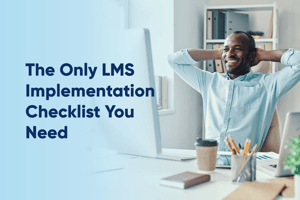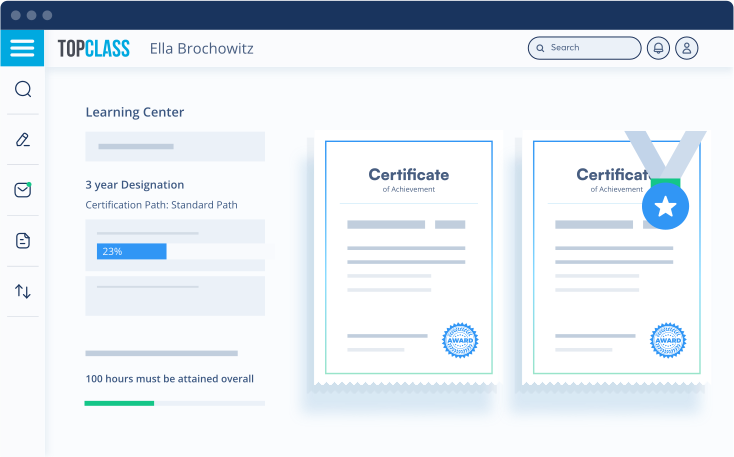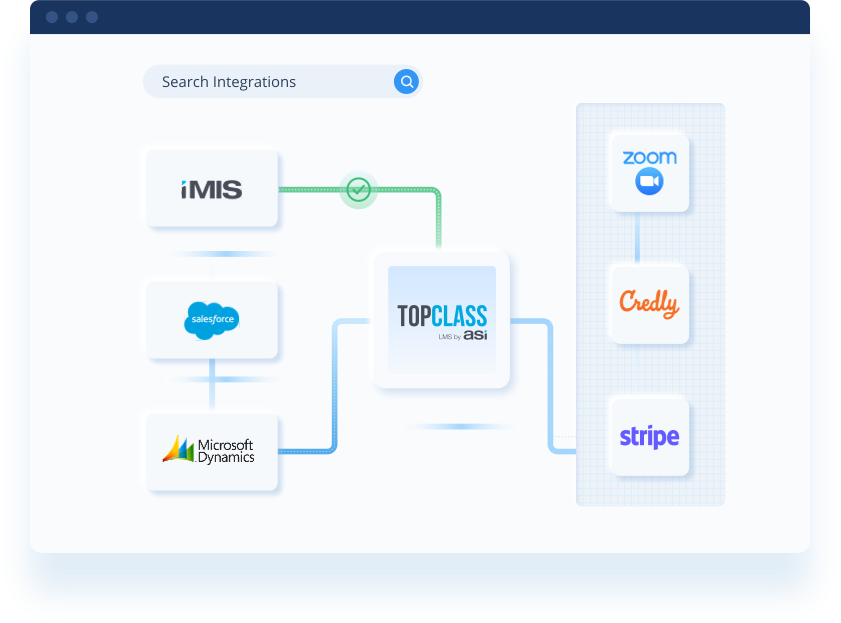
The Only LMS Implementation Checklist You Need: 9 Easy Steps
So, your organization has looked into the benefits of implementing a learning management system (LMS) and liked what you found. You’re in good company—a recent benchmark report by iMIS found that about one-third of surveyed membership organizations have either made or planned to make investments in a new LMS.
Researching and finding the right LMS for your organization are important steps, but they’re only the first on your journey to creating an engaging, high-value learning program.
That’s where this LMS implementation checklist comes in. We’ll walk through everything you need to know to get up and running with your new learning platform, including:
A well-executed implementation allows you to seamlessly fit your LMS into your organization’s existing operations and technology toolkit, enhancing your capabilities without disrupting your current workflow.

The Key to a Smooth LMS Implementation
Before jumping into the checklist itself, your team must consider one key factor for success: the LMS you choose to implement. To complete an implementation that meets your expectations, you must first find a solution that fulfills all of your needs.
After all, an association’s LMS requirements will likely differ from those of a company, since one is trying to engage members with professional development opportunities, and the other is trying to equip employees for success in their roles.
Use these steps to narrow down the perfect fit for your organization:

-
Identify your needs. Outline what you plan to accomplish with your learning program, gathering input from various departments such as IT and HR to inform your priorities. Set a clear budget for your LMS, accounting for both upfront costs and additional expenses associated with data migration or training.
-
Research LMS options. Explore software review websites like Capterra and individual LMS websites to learn more about each platform’s functionality and user experience. Consider partnering with an LMS consultant who has in-depth knowledge of providers, their strengths, and what exact features you need to meet your learning program’s goals.
-
Request demos. Schedule free demos of your top LMS choices to get a firsthand glimpse into how each platform works. Check to see whether the platform is easy to use, and look for comprehensive training and support resources. Depending on your budget, you may ask whether the vendor offers alternative pricing models, such as “per course enrollment” instead of upfront license fees.
While “free” open-source LMS platforms are available, they have major drawbacks, such as no support during implementation. Often, this leads to unforeseen costs of finding an external firm to implement and configure the platform rather than receiving direct help from the vendor.
Your Complete LMS Implementation Checklist for Success
While each LMS implementation process will vary depending on the organization’s needs and the level of vendor support provided, the foundational steps are the same. Follow this checklist to navigate your team through a seamless implementation project:

1. Define your LMS implementation goals and requirements.
Start by outlining what a successful implementation looks like for your organization. What do you ultimately hope to achieve with your new platform? For a nonprofit, this might involve increasing volunteer training completion rates. For a union, this might be speeding up the member onboarding process.
Use these questions to guide your thinking:
-
What activities or opportunities do you want to support with the LMS?
-
What outcomes do you want to achieve in the six months or one year following the implementation?
-
Do you already have learning content that needs to be migrated, or will you need to create new content?
-
What types of topics or skills will our learning program cover?
-
What existing systems do you need to integrate with the LMS?
-
What reports and analytics will you need to assess your learning program’s performance?
In 2024, 53% of associations reported an increase in professional development registrations, and 56% saw an increase in certification acquisition and maintenance. If your organization wants to provide compliance training and certifications as part of its learning program, for example, you might require an LMS that allows you to upload content that supports standardized eLearning content standards such as SCORM.
2. Assemble an LMS implementation team.
Implementing an LMS is no solo effort. Instead, it’s a detailed process requiring collaboration between your organization’s team and your LMS vendor’s team.

Your organization’s LMS implementation team should typically include:
-
A team leader who helps the project maintain momentum and steers it toward completion
-
A project manager in charge of developing and executing the implementation project plan
-
A representative from relevant departments such as HR, IT, marketing, and management
-
An executive sponsor who provides budget approval and secures buy-in from the rest of the leadership
Your LMS vendor’s implementation team should typically include:
-
An LMS project manager who assigns roles to the vendor’s project team and maintains open communication with your organization’s project manager
-
A business analyst who helps translate your learning program goals into technical requirements for the LMS
-
Developers who work to customize the LMS according to your organization’s specific needs
-
QA testers who check to ensure the LMS meets your organization’s expectations from every angle
With an LMS vendor that provides professional implementation services, your organization can better coordinate its resources, avoid budget overruns, and keep the process moving at a productive pace. If you didn’t partner with an LMS consultant during the selection process, consider reaching out to one of these experts to help you anticipate potential challenges and coordinate the implementation project using their hands-on experience.
3. Create an LMS implementation plan and timeline.
On average, it can take three to six months to implement a new cloud-based LMS and six to nine months to implement an on-site LMS for a large company. By producing a detailed LMS implementation plan and timeline upfront, you can prevent project scope creep and align your whole team on their next actions.
Your project manager should collaborate with the rest of your team to develop a project charter with the following details:
-
Objective
-
Requirements/Deliverables
-
Project Sponsor
-
Schedule
-
Budget
-
Team Member Roles and Responsibilities
-
Risks
-
Constraints
-
Success Criteria
Organize a kickoff meeting to review this charter as a team. Take this opportunity to establish communication expectations and schedule regular check-ins to assess progress throughout the implementation project.
4. Prepare your learning content.
Before launching a truly engaging learning program, you need to populate your LMS with educational resources and training materials. You can migrate your existing learning content, develop new content to upload, or leverage third-party content. Many organizations pull from a combination of these sources to build their learning program.
To make your educational offerings as compelling and accessible as possible, incorporate a variety of content formats and elements, such as:
-
Self-paced SCORM/AICC-compliant certification courses
-
Live webinars and workshops
-
Assessments and quizzes
-
Templates and worksheets
-
Learning leaderboards

According to the Society for Human Resource Management (SHRM), nearly 64% of employees prefer a simulation learning format, and 51% prefer a coaching/mentoring style. Your organization can pinpoint which types of educational content it should prioritize by surveying potential end users, from members to staff.
5. Set up your LMS and integrations.
During this LMS implementation step, it’s time to configure your learning platform to your organization’s liking. Generally, this will involve:
-
Adjusting settings such as notification preferences
-
Defining roles and permissions for administrators, instructors, and users
-
Importing or migrating user data to the platform
-
Customizing the LMS with your organization’s branding
Additionally, your LMS vendor’s team will help you integrate your LMS with your other important platforms, whether that’s your membership software or payment processor, and set up single sign-on (SSO). To streamline this process, identify an internal point of contact with technical expertise in your existing system to coordinate with the developers on a more granular level.

6. Announce your LMS launch.
Implementing a new LMS is a significant investment, which is why you need to start building excitement early to encourage your whole organization to embrace the platform once it’s launched.
Spread the word through multiple channels, including your:
-
Website. Create a dedicated page summarizing all your educational and training content, showcasing engaging elements such as personalized learning paths and gamification. Supplement this page with blog articles introducing your newest offerings, answer FAQs, and share testimonials from early testers or users.
-
Email newsletter. Send targeted emails to your audience highlighting various certifications and courses in your learning program. You can even invite recipients to attend a virtual tour or Q&A session to get familiar with the platform and everything it offers.
-
Social media. Come up with a hashtag to announce your LMS launch and promote your new learning opportunities to your audience. Plus, you can expand your reach by partnering with influencers within your sector and providing a course discount to followers who post about their engagement with your program.
Drum up even more enthusiasm by celebrating your LMS launch with a special virtual event. In this event, you can involve leadership and directly answer questions from potential users. You can also boost engagement from the start by providing limited-time discounts on premium courses and exclusive webinars.
7. Complete QA testing.
Before you roll out your LMS, you must ensure it’s up to standard. Does it meet all your requirements? Is it easy to use? Do all the integrations work properly? Your vendor’s QA team should step in to answer these questions. Here’s what you can expect the QA team to do:
-
Review your organization’s requirements to understand your ideal workflow.
-
Create test cases or scenarios to evaluate whether the LMS meets each requirement.
-
Check the accuracy of data migration to prevent information loss.
-
Assess whether your LMS layout is responsive on various devices, from laptops to smartphones.
-
Verify that the LMS meets accessibility standards.
If the QA testers encounter any bugs or issues during the process, they’ll note and share them with the development team to develop a fix.
8. Train your LMS users.
After QA testing is complete, it’s your organization’s turn to conduct user acceptance testing. First, however, you should train your staff to familiarize them with the platform’s interface and functionality. Take advantage of training sessions and resources offered by your LMS vendor. Some vendors, such as TopClass, include training hours in their contracts, which you can allocate for implementation and future training needs.
Typically, you should expect your LMS vendor to provide online training tailored to your organization’s specific platform needs and goals. These can be recorded, so anyone who missed a session can review it on their own time. However, if your organization has many staff members, you might opt to schedule on-site training instead.
After your organization has gotten to know the platform better, assemble a team to carry out user acceptance testing. During this process, you’ll identify and try out everyday procedures on your LMS, whether that’s purchasing a course or completing a certification path. Note any issues or challenges that arise during these procedures and collaborate with your vendor to resolve them before launch.
9. Track your LMS implementation results.
Once your new LMS is up and running, it’s time to set your learning program in motion. As you engage learners in your offerings, use your LMS’s reporting capabilities to measure your results. Some elements and metrics to consider include:
-
Course purchases
-
Course completion rates
-
Test results
-
Certifications or badges earned
-
Number of active users
Continue to make strategic improvements based on this data to enhance your program’s performance and get the most out of your LMS implementation over time.

3 Tips for Completing the LMS Implementation Checklist
With a detailed checklist to follow, your team has all the steps it needs to carry out a successful LMS implementation. However, to navigate through the process with confidence and efficiency, keep these tips in mind:
-
Establish clear requirements and needs upfront. Starting with everyone on the same page about your LMS expectations prevents delays or scope creep down the line. For example, do all the features you need come with the platform, or are there separate add-ons you must pay for? Are you satisfied with the baseline reporting capabilities, or do you want to access customized reports through your LMS?
-
Practice frequent and open communication. Schedule weekly progress calls with your team and vendor to share updates throughout the LMS implementation project. Additionally, your project manager should be available by email and phone between these meetings to address any questions or concerns. Note all decisions, changes, and task completions in an organized document to reference as needed.
-
Collect feedback from users. The most useful insights will come from those interacting with the LMS platform. Beyond user acceptance testing, create ongoing channels to collect feedback from learners and other users. For example, you can embed a survey within your LMS that asks about the user’s learning experience and whether they believe they can apply what they learned in their professional role.
Wrap up your LMS implementation project with a team debriefing. Review how the project went and discuss any insights you can carry into future software implementation efforts across your organization.
Breeze Through Your LMS Implementation Checklist with TopClass
At TopClass, we’re committed to helping your organization achieve success with its LMS—from start to finish. With our professional implementation services, we’ll be right by your side through the entire implementation project, ensuring that it stays on track with your budget, schedule, and quality expectations.
When the American Institute of Chemical Engineers (AIChE) needed to migrate and expand its 36 eLearning courses quickly, the association turned to TopClass’s industry-leading LMS and implementation services. With an in-depth understanding of AIChE’s needs, we were able to provide flexible pricing, a two-and-a-half-month implementation, and migrate 30 million rows of SCORM interaction data from a legacy LMS. Get a free demo to see how we can take your learning program to the next level!
A new LMS can be a game-changer for your organization’s learning program, allowing you to create tailored, engaging educational experiences for users of varying needs and preferences. Whether you’re hoping to earn more non-dues revenue or better prepare staff for their responsibilities, taking a careful and calculated approach to LMS implementation turns your goals from a dream to a reality.
Want to learn more LMS tips, tricks, and recommendations? Check out these additional resources:
-
The Leading Association LMS to Elevate Learning | TopClass. Discover why TopClass is the leading LMS choice for associations in 23+ countries worldwide.
-
Learning Management Systems for Nonprofits: A One-Stop Guide. Explore the benefits and key features of a nonprofit LMS and how to select one for your organization.
-
The Ultimate Guide to LMS Selection & Implementation. Download our free LMS selection and implementation guide to become a quick expert in these learning platforms.


